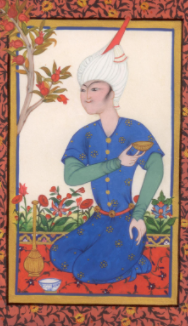
What are miniatures?
Answer
488.1k+ views
Hint: For books or albums, miniature paintings are created. These are done with materials like paper and cloth. Although the Palas of Bengal is credited with inventing miniature paintings in India, the art form reached its pinnacle under the Mughal rule.
Complete answer:
Miniatures - The word miniature comes from the Latin verb miniare, which means ("to colour with minium," a red lead ) and refers to a little drawing used to embellish an ancient or mediaeval illuminated manuscript; the early codices' modest illustrations were miniated or drawn with that pigment.
The small scale of such mediaeval paintings has led to etymological confusion with minuteness, which has been applied to little paintings, particularly portrait miniatures, which grew from the same tradition and employed comparable techniques at least initially.
The objective of miniatures –
People, animals, buildings, situations, and things are replicated in models and miniatures. Miniatures or miniatures are used to depict phenomena that do not exist or are too expensive or impossible to capture in real life, such as explosions, floods, or flames.
Types of miniature painting –
Miniature painting is distinguished by its fine brushwork, intricacy, detailing, and stylization. The miniature painting style has evolved into numerous schools of miniature painting across India, including Kangra, Rajasthan, Malwa, Pahadi, Mughal, Deccan, and others.
Miniature art consists of very small paintings, engravings, and sculptures, and it has a lengthy history dating back to prehistory. A common definition is that a work of miniature art is small enough to fit in the palm of one's hand or occupies less than 25 square inches.
Miniatures are miniature paintings created using watercolours on fabric or paper.

Note: Metal, plastic, and paper are common materials for miniature models. They are used to enhance the aesthetic components of a game as well as track character location, facing, and line of sight. Miniatures are usually painted and can be sculpted in many ways, making them collectable in and of themselves.
Complete answer:
Miniatures - The word miniature comes from the Latin verb miniare, which means ("to colour with minium," a red lead ) and refers to a little drawing used to embellish an ancient or mediaeval illuminated manuscript; the early codices' modest illustrations were miniated or drawn with that pigment.
The small scale of such mediaeval paintings has led to etymological confusion with minuteness, which has been applied to little paintings, particularly portrait miniatures, which grew from the same tradition and employed comparable techniques at least initially.
The objective of miniatures –
People, animals, buildings, situations, and things are replicated in models and miniatures. Miniatures or miniatures are used to depict phenomena that do not exist or are too expensive or impossible to capture in real life, such as explosions, floods, or flames.
Types of miniature painting –
Miniature painting is distinguished by its fine brushwork, intricacy, detailing, and stylization. The miniature painting style has evolved into numerous schools of miniature painting across India, including Kangra, Rajasthan, Malwa, Pahadi, Mughal, Deccan, and others.
Miniature art consists of very small paintings, engravings, and sculptures, and it has a lengthy history dating back to prehistory. A common definition is that a work of miniature art is small enough to fit in the palm of one's hand or occupies less than 25 square inches.
Miniatures are miniature paintings created using watercolours on fabric or paper.

Note: Metal, plastic, and paper are common materials for miniature models. They are used to enhance the aesthetic components of a game as well as track character location, facing, and line of sight. Miniatures are usually painted and can be sculpted in many ways, making them collectable in and of themselves.
Recently Updated Pages
You are awaiting your class 10th results Meanwhile class 7 english CBSE

Master Class 12 Business Studies: Engaging Questions & Answers for Success

Master Class 12 Economics: Engaging Questions & Answers for Success

Master Class 12 English: Engaging Questions & Answers for Success

Master Class 12 Maths: Engaging Questions & Answers for Success

Master Class 12 Social Science: Engaging Questions & Answers for Success

Trending doubts
Convert 200 Million dollars in rupees class 7 maths CBSE

i What trees does Mr Wonka mention Which tree does class 7 english CBSE

What are the controls affecting the climate of Ind class 7 social science CBSE

What was the main occupation of early Aryans of rig class 7 social science CBSE

Write a letter to the editor of the national daily class 7 english CBSE

Welcome speech for Christmas day celebration class 7 english CBSE





